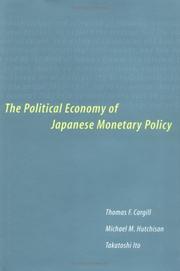| Listing 1 - 5 of 5 |
Sort by
|
Book
Year: 2012 Publisher: Tokyo Bank of Japan. Institute for monetary and economic studies
Abstract | Keywords | Export | Availability | Bookmark
 Loading...
Loading...Choose an application
- Reference Manager
- EndNote
- RefWorks (Direct export to RefWorks)
Banks and banking, Central --- -Monetary policy --- -Nihon Ginkō.
Periodical
ISSN: 09191380 Year: 1993 Publisher: Tokyo
Abstract | Keywords | Export | Availability | Bookmark
 Loading...
Loading...Choose an application
- Reference Manager
- EndNote
- RefWorks (Direct export to RefWorks)
Private finance --- JP / Japan - Japon --- Periodicals --- Securities --- Nihon Ginkō --- Japan --- Economic conditions
Book
ISBN: 0300263007 Year: 2021 Publisher: New Haven : Yale University Press,
Abstract | Keywords | Export | Availability | Bookmark
 Loading...
Loading...Choose an application
- Reference Manager
- EndNote
- RefWorks (Direct export to RefWorks)
A rare insider's account of the inner workings of the Japanese economy, and the Bank of Japan's monetary policy, by a career central banker.
Monetary policy --- Banks and banking, Central --- Bankers --- History --- Philosophy. --- Shirakawa, Masaaki. --- Nihon Ginkō --- Presidents --- Japan --- Economic conditions

ISBN: 0262032473 026251527X 0262269880 0585023581 026226207X 9780585023588 9780262269889 9780262032476 Year: 1997 Publisher: Cambridge, Mass. MIT Press
Abstract | Keywords | Export | Availability | Bookmark
 Loading...
Loading...Choose an application
- Reference Manager
- EndNote
- RefWorks (Direct export to RefWorks)
The contributions in this book provide a unique view of its emergence and growth in a number of different national settings in an area of the Third World where the industry is most advanced. The motor vehicle industry has had a dramatic impact on industrialized societies, shaping the structure and productive processes of capitalist economies and defining consumer life styles. The industry's impact on the Third World has been no less significant. The contributions in this book provide a unique view of its emergence and growth in a number of different national settings in an area of the Third World where the industry is most advanced. They explore what occurs when the world's leading consumer durable is produced and sold in a context of dependency and underdevelopment. Chapters by Kenneth S. Mericle, Rhys Jenkins, and Rich Kronish examine the political economy of the motor vehicle industry as it has evolved in Brazil, Argentina, and Mexico, stressing the importance of the structural problems it has encountered. Chapters by John Humphrey, Judith Evans, Paul Heath Hoeffel and Daniel James, and by Ian Roxborough focus on the role and impact of labor in the same three countries. Chapters by Douglas Bennett and Kenneth Sharpe, and Michael Fleet (on the industry in Colombia) discuss the bargaining process between the transnational vehicle corporations and the Latin American governments. A concluding chapter by the editors summarizes the study and offers a history of the industry in the three principal countries from 1900 to 1980.
Monetary policy --- -Banks and banking, Central --- -332.4952 --- Banker's banks --- Banks, Central --- Central banking --- Central banks --- Banks and banking --- Monetary management --- Economic policy --- Currency boards --- Money supply --- Nihon Ginkō. --- Bank of Japan --- Japan. --- Nichigin --- Nippon Ginkō --- 日本銀行 --- Japan --- -Monetary policy --- Banks and banking, Central --- ECONOMICS/Trade & Development --- Nihon Ginko.
Book
ISBN: 1501728180 9781501728181 Year: 2018 Publisher: Ithaca, NY
Abstract | Keywords | Export | Availability | Bookmark
 Loading...
Loading...Choose an application
- Reference Manager
- EndNote
- RefWorks (Direct export to RefWorks)
Bolder economic policy could have addressed the persistent bouts of deflation in post-bubble Japan, write Gene Park, Saori N. Katada, Giacomo Chiozza, and Yoshiko Kojo in Taming Japan's Deflation. Despite warnings from economists, intense political pressure, and well-articulated unconventional policy options to address this problem, Japan's central bank, the Bank of Japan (BOJ), resisted taking the bold actions that the authors believe would have significantly helped.With Prime Minister Abe Shinzo's return to power, Japan finally shifted course at the start of 2013 with the launch of Abenomics-an economic agenda to reflate the economy-and Abe's appointment of new leadership at the BOJ. As Taming Japan's Deflation shows, the BOJ's resistance to experimenting with bolder policy stemmed from entrenched policy ideas that were hostile to activist monetary policy. The authors explain how these policy ideas evolved over the course of the BOJ's long history and gained dominance because of the closed nature of the broader policy network.The explanatory power of policy ideas and networks suggests a basic inadequacy in the dominant framework for analysis ofthe politics of monetary policy derived from the literature on central bank independence. This approach privileges the interaction between political principals and their supposed agents, central bankers; but Taming Japan's Deflation shows clearly that central bankers' views, shaped by ideas and institutions, can be decisive in determining monetary policy. Through a combination of institutional analysis, quantitative empirical tests, in-depth case studies, and structured comparison of Japan with other countries, the authors show that, ultimately, the decision to adopt aggressive monetary policy depends largely on the bankers' established policy ideas and policy network.
Banks and banking, Central --- Deflation (Finance) --- Monetary policy --- Banker's banks --- Banks, Central --- Central banking --- Central banks --- Banks and banking --- Disinflation --- Finance --- Nihon Ginkō. --- Bank of Japan --- Japan. --- Nichigin --- Nippon Ginkō --- 日本銀行 --- Japan --- Economic policy --- E-books
| Listing 1 - 5 of 5 |
Sort by
|

 Search
Search Feedback
Feedback About UniCat
About UniCat  Help
Help News
News